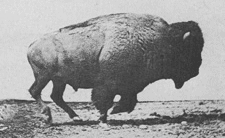

Click here to learn the story.
 |
 Click here to learn the story. |
...but only a bit.
Here are some images I just found thanks to Google:

Really nice machine, which is now mysteriously on display at an exhibit rather than at a cinema running movies. This is the honorable Bauer U2, which could rather easily be switched from 35mm to 70mm and back again in a matter of minutes. Again, I never ran one of these beauties, but I have seen them. At the Town Cinema in Lackawanna, to be exact. Wonderful. I tried to rescue them, but when the building went down, the machines went down with it.

And here’s a closer look, with the door open. Nice, huh?

Huh? Is this from the same Simplex that sold machines in the US?
This model, though, was surely never marketed here.
Those huge magazines confuse me.
Then a collector assured me that those magazines are not huge at all. They are 2000'. Everything else, he says, is extremely small.
My guess is that this was put on the market in 1929 or 1930.

And what about this? When did this first hit the market? Those magazines are huge, and would hold, I guess, 5,000' or 6,000' of film.
Italian features all had intermissions at about the half-way mark, 45 or 60 minutes into the story.
The size must have increased in later models, for the intermission in Salon Kitty was at about the 7,000' mark.
An actual photograph of one of these beasts follows:

I need to learn more about this. It was probably modified for Cinemascope (see the holder for the extra lens in front of the regular lense, though that could have been for Magnascope or some other oddball process), and the large magazines may have replaced original ones that were smaller. I don’t know. When was this machine first put on the market?

Well, this one’s not attractive, is it?
I assume this was put on the market in 1953 or 1954.
Note the three lenses in the turret.
Of course, if you want to be able to show easily and properly
any 35mm film in circulation, you need seven lenses, not three.

The above includes a Super Simplex picture head, which was put on the market in November 1929.
For those who have wished to argue with me, please note that there is no sound mechanism,
and there is a hand crank as well as a base-mounted single-phase AC motor and a variable-speed pulley.
You have always wondered why the shutter shaft was so long that it came right through the front of the machine.
Well, now you know: It held a belt that drove the speed indicator.
So please, I never again want to hear that the Super Simplex was introduced to the market in 1934.
Please.
Yes, it’s a lot of fun to play with these machines, but the pay is lousy and the work is thankless.
Original research and commentary copyright © 2009 by Ranjit Sandhu. All rights reserved.